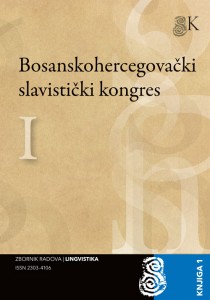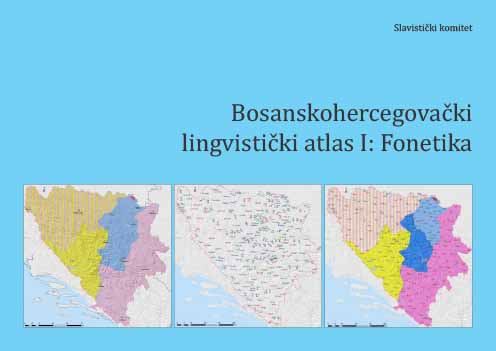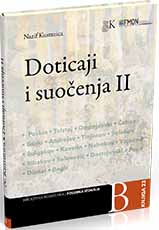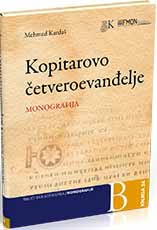


Keywords: linguistic atlas; Bosnian language; Croatian language; Serbian language; phonetics; morphology; etymology; lexis; dialects; štokavian; ijekavian; ikavian;
Speech within the borders of Bosnia and Herzegovina falls within four sub-dialects of the štokavian dialect: Eastern Bosnian, Eastern Herzegovinian, Posavinian (or Slavonian) and Western.Two of them are non-novoštokavian (Eastern Bosnian and Posavinian) and two are novoštokavian (Eastern Herzegovinian and Western). Eastern Bosnian is ijekavian šćakavian, Eastern Herzegovinian is ijekavian štakavian, Posavinian is ikavian-jekavian štakavian, and Western isikavian štakavian-šćakavian. Two novoštokavian sub-dialects cover approximately two thirds of the territory of Bosnia and Herzegovina, and two non-novoštokavian cover one third, with the Posavinian sub-dialect covering the smallest territory: only seven villages in the Orašje municipalitys peak in this dialect. Eastern Bosnian and Western sub-dialects are spoken by Bosniaks and Croats, Serbs to a lesser extent; Eastern Herzegovinian is spoken by Bosniaks, Croats and Serbs; Posavinian is spoken by Croats only. Traces of the old division of the štokavian dialect into eastern and western variants is still evident in the speech varieties in contemporary Bosnia and Herzegovina: some reflect features of western štokavian origin, and some of the eastern štokavian. Frequent migrations and mixing of the population of different dialects contributed to the diversity of speech across the country. Moreover, with a pronounced religious and ethnic blending of the population, the dialects in Bosnia and Herzegovina are quite interesting.Scholarly literature on dialectology presents basic information about speech in Bosnia and Herzegovina.However, neither major monographs nor various contributions in the field of dialectology produced from the end of the 19th century onwards offer a view of linguistic phenomena in speech in Bosnia and Herzegovina as a whole – only linguistic atlases provide the geographic spread of certain phenomena in the given language coverage. Systemic linguo-geographic study of BiH speech has been made possible thanks to the material obtained through uniform questionnaires developed as part of the project entitled “BiH Dialectological Complex – Synchronous Description and Position of the Contemporary Standard Language” by the Language Institute in Sarajevo. The BiH Language Atlas (BLA) is based primarily on this corpus, collected throughout 1970s and 1980s. Field research continued in 2016 and 2017 with amendments to some of the questionnaires and the collelction was expanded by recordings from four previously unexplored speech varieties; BLA thus covers 230 local speech varieties. Speech by Bosniaks was researched in one hundred locations, speech by Serbs in eighty, and speech by Croats in fifty. Although speech has been changed considerably, due to movement and relocation of the population during the war in the early 1990s, materials collected between 1975 and 1986 and those from 2016 and 2017 are comparable and create a whole that allows for the production of a national linguistic atlas.The phonetic volume of BLA is the first in a series of volumes planned to be published, and itis the fruit of labour of more than thirty collaborators of the Slavic Committee. The introductory part presents key information about the project itself, a list of speech varieties examined,a list of orthographic markings of speech varieties covered, a list of field researchers with the number of questionnaires completed, a phonetic transcription system, a register of lexemes and a map of dialects and sub-dialects in Bosnia and Herzegovina. The main part is dedicated to themost important phonetic phenomena: of a total of 181 questions, 63 relate to vocalism and 118to consonantism. It contains transcribed recordings of speech varieties examined, a linguistic interpretation of the material, commentaries regarding the ethymology of the lexemes and maps with symbols representing the corpus, allowing th tracking of isophones, determination of areal features of certain phenomena, specification of dialect boudnaries and an overview of horizontal spread of BiH dialects. Each map includes a legend and data on the presence of specific forms with graphic representation. The lettering is in three colours (green: examined speech by Bosniaks;blue: speech by Croats; red: speech by Serbs) in order for the maps to reflect at the same time the differences based on the informants’ ethnic background. The annex present a word index,a list of cited bibliography, as well as a list of abbreviations, markings and graphic symbols.
More...
Keywords: Bosnian literature; Russian literature; comparative literature;
The first edition of the second book of essays Doticaji i suočenja II (Contacts and Confrontations II) was published in the year 2002 by the Faculty of Philosophy in Sarajevo. The book begins with an essay dedicated to the 200th anniversary of the birth of Alexander Pushkin entitled In the Beginning Was Pushkin. Referring to the well-known critical evaluations of Russian researchers, who rightly call Pushkin Adam of Russian Literature and The Principle of all Principles, Nazif Kusturica shows why it is said that this great artist of words, originated in the era of romanticism, is the founder of Russian realism and modern, original Russian literature.In the essay On Tolstoy’s epopee the author explains the concept of the novel-epopee and talks about War and Peace as a unique novel, that did not find a typological relative before the novel Quietly Flows the Don by Sholokhov. Aware of his innovation in the novel structure, Tolstoy only found similarities with his work in Homer’s Iliad. Intending to show Tolstoy’s transition from epic to drama, Kusturica also talks about the features of epic in the drama The Power of Darkness, reminding that Tolstoy is also an outstanding playwright.Based on the statement that Dostoevsky’s realism is firmly marked by romance, the author shows, by the example of the novel Poor Folk, in which way Dostoevsky had rehabilitated (N. K.) the sentimental principle of his characters, on which realism challenged his right.From Gogol’s ‘The Overcoat’ to Chekhov’s ‘Case’ is an essay in which the author of the book tells about the development of the theme of the little man, comparing two typologically related models – Gogol’s Bashmachkin and Chekhov’s Belikov. Having described one of the most important themes of great realism in Russian literature in the previous essay, the author also brings an extremely informative essay about Chekhov’s stories.Chekhov dealt with topics that were of great importance for the further development of Russian literature, and some of them: the responsibility of a small man for his destiny, chameleonism, the banalization of the Russian intelligence...
More...
Keywords: Jerinej Kopitar; Gospel; Bosnian Church Slavonic; Glagolitic script; Cyrillic alphabet;
Stored in the National and University Library in Ljubljana under the signature mark Cod. 24, Kopitar’s gospel is one of about thirty preserved texts of the Bosnian Church Slavonic literacy. The codex was written in the second half of the 14th century under the auspices of members of the Bosnian Church, but soon after the fall of the Bosnian Kingdom it was preserved in an Orthodox monastery, where its original appearance was changed by reparations and adjustments to suit the Serbian Orthodox Church liturgy.The philological analysis of this relatively well-preserved codex imposed itself as a research task whose results should provide the most important knowledge about the codex itself and the process of editing its text at all levels of realization, as well as the position of the manuscript in relation to the Church Slavic canonical and the Bosnian group of codices.The entire codex, which is by all features – codicological, graphetic and linguistic – a typical representative of the Bosnian tradition, was more or less carefully written in the Bosnian Cyrillic by one scribe. The majority of medieval Bosnian religious texts were written in the same type of this version of the Cyrillic alphabet, which, along with lapidary and office script,represents a version of the Western Cyrillic script.Orthographic features of Kopitar’s gospel are shown in adhering to the Bosnian spelling tradition, which follows the oldest Old Church Slavic matrix, primarily the Glagolitic script, which is confirmed in the solutions of ambivalent values of individual letters. In addition to their true values, the letter ѣ has the value /ja/; the letter е serves as the value /je/ in the initial and post-vowel position; letters л and н entail the values /ĺ/ and /ń/; whilethe letter jerv only had the value /đ/ for the scribe of Kopitar’s gospel. Aslight distance from the Bosnian spelling tradition can be assumed in amore frequent use of ligature ѥ.The language of Kopitar’s gospel marks the breakthrough of dialectal innovations from the Western Shtokavian base. Besides Ikavian as a distinguishable feature of this literacy which is in Kopitar’s manuscript massively present and most likely indicates the Ikavian organic idiom of the scribe, other western features are also registered in the codex: the reflex/j/ < *dj, and, rarely, the reflection of the group va < vь. Furthermore, in the entire codex, other linguistic features are recorded, which testify about the condition of the Shtokavian speech during the second half of the 14thcentury, such as the vocalization of the semivowel u /a/, the reflex /u/ < vь,etc. Since there are no examples in the codex of changing the final l > /o/which is found in other Bosnian gospels written at the end of the 14th and the beginning of the 15th century, this leads to the conclusion that the time of writing of Kopitar’s manuscript could be moved towards the middle of the 14th century.
More...